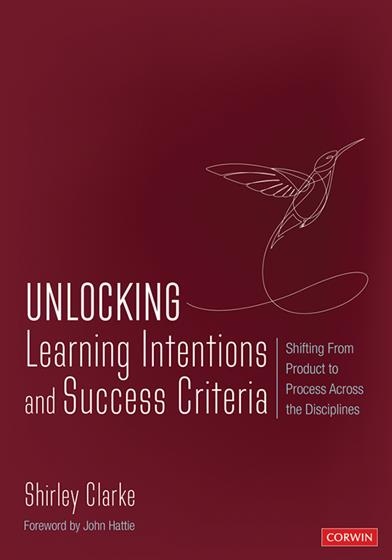Foreword
Preface
The Background and Lead-Up to This Book
How This Book Is Organized
Acknowledgments
PART I: SETTING THE SCENE
Chapter 1: Summary of the Key Messages
Why the Move From Product to Process?
What We Know About Learning Intentions and Success Criteria
Chapter 2: Learning, Not Doing: The Evidence
Clarity
Knowing How to Get There
The Evidence for Learning Intentions and Success Criteria
PART II: LEARNING INTENTIONS: A CLOSER LOOK
Chapter 3: Planning the Learning
The Big Picture
Knowledge and Skills
The Differences in Planning for Primary and Secondary
Getting the Wording Right
Chapter 4: Sharing Learning Intentions With the Students
In-Lesson Organization
In-Lesson Feedback and Evaluation
The Impact of Sharing and Clarifying Learning Intentions
PART III: SUCCESS CRITERIA: A CLOSER LOOK
Chapter 5: Process Success Criteria: A Framework for Learning and Self-Regulation
Defining Process Success Criteria
Planning Process Success Criteria for Skills
Writing Learning Intentions and the Implications for Their Success Criteria
Include Knowledge Key Points Alongside Skill Success Criteria
Everlasting Learning Intentions
Chapter 6: Co-Constructing Success Criteria
Why Take the Time to Co-Construct?
Strategies for Whole-Class Co-Construction
Examples of Co-Constructed Success Criteria Across All Ages and Subjects
What Happens to the Co-Constructed Success Criteria?
The Impact of Co-Constructed Process Success Criteria
Chapter 7: Planning a Lesson
Follow the Path for Skills, Knowledge, or Both
How Do Learning Intentions and Success Criteria Work in the Flow of a Lesson?
PART IV: DIFFERENCES BETWEEN SUBJECTS
Chapter 8: Literacy: Writing
Planning Graphic for Writing
Skills—Open or Closed
Examples of Literacy Skills With Knowledge Links
Breaking Down Success Criteria for Closer Focus
The Critical Issue of Quality and Knowing What Good Examples Look Like
Comparing Good and Poor Examples
How to Compare and Analyze Contrasting Examples of the Previous Class’s Writing
Chapter 9: Mathematics
Planning Graphic
Examples of Lesson-Based Skill Learning Intentions and Process Success Criteria
Intervention When Students Need More Support
Worked Examples and the Use of Success Criteria
Don’t Have Too Many Criteria!
Incorporating Decision-Making
Students Create Their Own Success Criteria
From Specific Skill Teaching to Application Problem-Solving
Chapter 10: Science
The Planning Graphic
From Primary to Secondary
Giving the Game Away
Examples of Science Learning Intentions and Success Criteria
Chapter 11: History and Geography
History Examples
Geography Examples
Chapter 12: Examples From Other Subjects
Art
Music
Drama
Design Technology
PART V: IMPLEMENTATION
Chapter 13: Whole-School Development
A Culture for Change
Support of School Leaders
Resourcing
Staff Meetings
Timescale: What Should We Do First, Next, and So On?
Whole-School Success
Chapter 14: Teachers’ Anecdotes About Implementing These Strategies
Anecdotes From Teachers in Learning Teams From 2017 Through 2020 . . .
Final Words
References
Index



